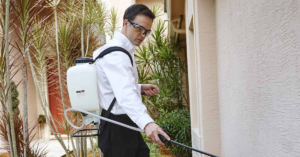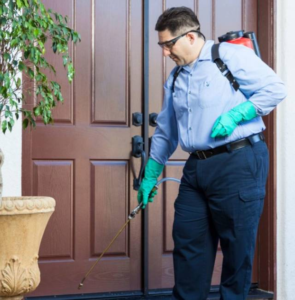An article is a noun or part of a noun that modifies, describes, or limits the meaning of another noun. An example of an article is a book.
Preventive measures can prevent pests from accessing food, water, and shelter. Eliminate clutter to limit hiding places and close off entry points that allow pests to enter. Visit Our Website to learn more.

Prevention is a key part of any pest management program. It involves identifying and eliminating conditions that attract pests, making them less likely to enter buildings or spread within them. A preventive approach may include routine inspections of commercial or residential properties to detect and address problems before they become widespread, sealing cracks and gaps that pests use to gain entry into buildings, maintaining good sanitation practices in retail or hospitality spaces to eliminate food sources for pests, removing weeds and other plant material where insects and rodents might nest, installing screens on windows and doors, and regularly checking and cleaning traps and bait stations.
Many pests are a health hazard, spreading disease-causing pathogens and triggering allergic reactions in people, including cockroaches, mice and rats. Others damage property, like wood-boring bees, silverfish and earwigs, stain surfaces or create unpleasant smells (like cluster flies and pine seed bugs).
In addition to regular inspections, preventive methods involve deterring pests by making the environment unwelcoming, reducing attractants and using physical barriers to entry. Keeping trash cans closed and in designated areas, reducing clutter, and trimming trees and shrubs can all help to keep pests away.
When preventive measures fail or they are not possible, pest control becomes more focused on suppression and eradication. Suppression is about reducing the pest population to a level that will cause acceptable levels of harm. It often goes hand in hand with prevention because once an infestation has been controlled, the goal should be to prevent it from occurring again.
In order to do this, you will need to identify the factors that are attracting the pests to your site. This will be difficult, especially if the pest is attracted to specific materials or scents that cannot be removed. In these cases, the best option is to treat the area with a barrier treatment that will block the pests from entering. This will be more cost effective than repeated treatments that could be needed if a preventive strategy is not implemented. The barrier treatment will also be safer for the environment than a continuous spray of insecticides.
Suppression
Pest control is the process of eliminating or reducing unwanted organisms that damage plants, animals or property. Common pests include rodents, cockroaches, termites and bed bugs. Some pests cause serious health problems, such as rabies and other diseases transmitted by bats (like European Bat Lyssavirus, or EBL). Pests are also damaging to the environment, destroying habitats or introducing new species that could compete with native organisms.
Pests are controlled using a variety of tactics, including physical, biological and chemical methods. These include removing or blocking nests, constructing barriers, controlling water flow, temperature control and other environmental modifications, and spraying or baiting. The type of tactic used depends on the pest, its location, and the desired outcome. Some pests, like cockroaches, produce allergens that affect 7-8% of the population. Without pest control, food hygiene, disease management and other public health measures would not be possible.
The natural environment is a powerful force that influences pest populations. Climate, for example, directly affects the growth of plants that pests consume and may kill or suppress them. Natural barriers, such as mountains and large bodies of water, restrict the spread of some pests. Availability of food, water and shelter also affects pest populations.
Biological controls include predators, parasitoids, and pathogens that can help regulate pests or eliminate them entirely. These are often effective in limiting the use of toxic chemicals. They include birds, reptiles, fish, amphibians and mammals that feed on some pests or prey on them. Certain fungi and bacteria can also suppress or kill pests by disrupting their internal functions.
Chemical pest control includes a wide range of chemicals that can be used in a targeted manner to limit the amount of exposure humans and other animals have to harmful agents. Many of these are not as toxic as previously thought and can be used in combination with non-chemical pest control measures.
The success of any pesticide application depends on its correct identification and timing. If a pesticide fails to reduce a problem, it is important to determine why it failed and to take corrective action. It may be that the chemical was not applied correctly or at the correct concentration. It may also be that the pest was in a life cycle stage or location where it was not susceptible to the agent.
Eradication
Eradication is a rare goal in outdoor pest situations, where prevention and suppression are more common. However, it may be necessary in enclosed environments such as factories, schools, hospitals and offices. In these settings, pests can cause unacceptable harm, such as contaminating food or materials.
An eradication program seeks to kill the entire population of a pest by targeting all places where the species may be found. This can be done through targeted spraying or trapping, or by killing or sterilizing the animals that are causing the problem. Eradication is often a more time-consuming approach than preventive or suppressive strategies, and it can be particularly difficult to accomplish in cases where the pest is already widespread.
The word eradicate originated as a verb meaning “to pull up by the roots.” This makes sense, given that eradication involves targeting the pest at the very root of its existence. The word has also evolved to mean a complete destruction of the pest, whether by killing it or preventing its reproduction. Current eradication efforts are underway in the United States for several problematic invasive species, including the Japanese beetle, northern giant hornet, and the spotted lanternfly.
In man-made habitats, eradication campaigns are less likely to succeed when they are initiated after the extent of the infestation reaches a critical threshold. In these instances, the likelihood of success is significantly enhanced if modern diagnostic (i.e., molecular) techniques are used to identify the source of the infestation, and the likelihood is further increased if the campaign is begun within four years after the onset of the invasion or its detection.
It is important to note that the probability of successful eradication can be significantly enhanced by applying critical sanitary measures, such as banning the transfer of infested material. This is important because a key tool in the elimination process is verification that the infestation has been completely eliminated, which can only be accomplished by destroying the pest population in all accessible locations. This type of eradication requires the highest level of coordination between all affected parties, which can be difficult to achieve in large-scale international operations.
Monitoring
In IPM, monitoring is a critical step to understanding pest populations in a field or building and when control action may be needed. This involves regularly checking and identifying insect, pathogen and weed pests, as well as their injury to crops, and making accurate, time-stamped observations (see Resources). It’s important to note that monitoring programs are site, crop- and pest-specific and should be adapted to local conditions.
Accurate identification is critical for all pest management decisions. Pests are divided into continuous and sporadic pests and potential pests depending on whether they are almost always present or only a problem under specific conditions, such as when a certain crop is in bloom. Threshold levels are also established based on a variety of factors, including aesthetic concerns and sanitary conditions in food processing plants or operating rooms of health care facilities.
Monitoring can be done by examining crops for damage or by observing the behavior of pests in their natural environment. Monitoring can also include collecting data on environmental conditions, such as temperature and moisture, to help predict pest population peaks and movement across fields or sites. This data may be collected through a spreadsheet or other form of electronic record-keeping and can be used to determine the onset of pests in crops, patterns of their movement, life stages, abundance and distribution within a crop and the effectiveness of control tactics.
For example, using a spreadsheet to collect trap counts can allow growers to map the locations of pests and identify the areas that need immediate control. Monitoring can also be combined with climate monitoring, such as tracking growing degree days or humidity, to predict pest populations and their susceptibility to disease or insects, or with weed mapping.
While spreadsheets and simple cameras can be used to monitor pest problems on a small scale, more benefit can be gained by participating in regional or national pest monitoring networks that are tailored for scouts and use customized digital data collection software (see Resources). One such network is VegNet, an ongoing project to develop a community-based reporting system for vegetable crop pests.
